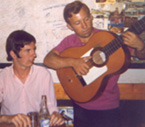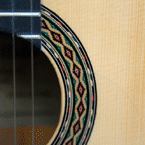Welcome to one of the most active flamenco sites on the Internet. Guests can read most posts but if you want to participate click here to register.
This site is dedicated to the memory of Paco de Lucía, Ron Mitchell, Guy Williams, Linda Elvira, Philip John Lee, Craig Eros, Ben Woods, David Serva and Tom Blackshear who went ahead of us.
We receive 12,200 visitors a month from 200 countries and 1.7 million page impressions a year. To advertise on this site please contact us.
|

|
|
modes and scales
|
You are logged in as Guest
|
|
Users viewing this topic: none
|
|
Login  | |
|

   
Paleto
Posts: 243
Joined: Jul. 29 2003
From: San Diego, CA

|
 RE: modes and scales (in reply to jrabbani) RE: modes and scales (in reply to jrabbani)
|
|
|
Try "The Guitar Grimoire: A Compendium of Formulas for Guitar Scales and Modes " by Adam Kidmon.
The only problem with his book is that he doesn't try to tell the reader how to use them, and doesn't really detail how to practice them, I think you have to discover that for yourself. This is a major undertaking, but it will open up the guitar to you *if* you can discipline yourself to do the work.
I would suggest getting "The Advancing Guitarist" for suggestions on how to practice the scales and modes. Mick Goodrick gives some very intelligent suggestions that are time consuming, but lead to a comprehensive understanding. Many of the suggestions are rather philosophical sounding, and take some experience to appreciate, it is kind of a do it yourself book, where the suggestions lead to importnat discoveries and realizations, but take a a lot of time to work out.
I think I'm going to go get the Grimoire Scales and Modes, and start working on this for a while, it might be fruiful to share ideas and experiences with any in the foro who wants to.
-Anthony
|
|
|
|
REPORT THIS POST AS INAPPROPRIATE |
Date May 13 2007 20:14:37
 |
|
Guest

|
 RE: modes and scales (in reply to Paleto) RE: modes and scales (in reply to Paleto)
|
|
|
dont know what to say but i ve been playin flamenco guitar alone without a teacher since 7 years and didnt study any scales or moodes till now , and then since 1year i begin to do so and the result is zero i dont have a passion to site and play scales and moods byt the way i am 29 years ... is it to late or what ... by the way i ve a lot of books and cds about theorey but dont know why it makes me board when i begin to study theorey ...is it may be cause i took alot of effort in studying flamenco on the gypsies way from cds and tabs or what can any body tell me what to do i belive that there is some people is more experiance than me in this .. is it too late or what???????? 
_____________________________
|
|
|
|
REPORT THIS POST AS INAPPROPRIATE |
Date May 13 2007 21:05:21
 |
|

   
Paleto
Posts: 243
Joined: Jul. 29 2003
From: San Diego, CA

|
 RE: modes and scales (in reply to Guest) RE: modes and scales (in reply to Guest)
|
|
|
doublekk2,
It sounds like maybe the information you have gotten, was too piecemeal, too separated by gaps that keep you from connecting what you have learned, to being able to apply it to music.
I would say that what you could do, is try to apply the theory in the context of some falsetas. For example, take a falseta you like, and transpose it to another key, take one from soleá, and change it to major, and plug it into alegrías, see how different they sound when transposed. Then change things within the falseta to learn to hear what the effect is of changing that particular note, of there are some C natural notes in the soleá, see how it sounds to play them C natural in alegrías. Learn to use scales to connect chords in any song type (bulerias, taranta, farruca or anything else. Try to learn to change key in one song you like. Let's say you have learned 5 Tomatito falsetas in bulerías, see if you can transpose one or two into a different key, then switch back and finish in the original key.
These things create a new feel and new sound to the same falseta, but you have to know how scales/modes work in order to do it.
Once this skill is developed, there are a lot of things that begin to fall in place, and that you learn by doing this.
-Anthony
|
|
|
|
REPORT THIS POST AS INAPPROPRIATE |
Date May 13 2007 21:33:15
 |
|

   
Paleto
Posts: 243
Joined: Jul. 29 2003
From: San Diego, CA

|
 RE: modes and scales (in reply to Jim Opfer) RE: modes and scales (in reply to Jim Opfer)
|
|
|
Hey Jim,
Don't feel like you're the only one. I think a majority of flamenco guitarists probably wish they could say they knew modal playing, and enough scales to express what they wish. The project is a major undertaking, but well worth the work if you can discipline yourself to do it, or at least some of it.
I still have tons to learn, but was lucky to have had a good teacher (rock music) in high school who made learning the basics palatable. The pay off then was being able to figure out and play neoclassical metal and other alternative music. I have had it in my mind a for a while that I should spend some serious time learning to apply modal ideas in context.
You can learn anything pretty much without reading notation, scales and modes included. The Guitar Grimoire books contain non-notated diagrams of most scales you would ever need, so don't worry about the notation part. Just pick one up and start to learn how chords and arpeggios are built from scales, then try to take those chords and arpeggios and scales and piece them together in interesting ways. That last sentence requires a couple years of working out thos details, but the payoff is pretty much infinite possibility. I think most guitarists get bored and lose focus, or feel like they can't spend the time or pay attention long enough, and they stop trying. It is truly a lot of work, but it does pay off after a while.
The Advancing Guitarist book does require reading notation, unless you read the suggestions for practice, and apply them to the scales in the Grimoire, bypassing the notated scales.
I would recommend buying both, and after learning the major scale in one key, play all the modal scales built from the same notes over different chords in the same key, sa y C major. The payoff would be enormous for soleá, which when played por arriba would fit well, except you have to make E major instead of minor.
It would be good to hear Ricardo's thoughts here..
-Anthony
|
|
|
|
REPORT THIS POST AS INAPPROPRIATE |
Date May 14 2007 2:50:40
 |
|

   
wiseguy493
Posts: 73
Joined: May 9 2007

|
 RE: modes and scales (in reply to Guest) RE: modes and scales (in reply to Guest)
|
|
|
Howdy flamenco players =)
The topic of chord and scale theory and how it applies to flamenco is something that has always left me feeling rather overwhelmed in how to approach teaching/understanding it all.
When I began playing flamenco, I had been formally trained in both classical and jazz music separately and for me everything made sense through theory. As I learned flamenco, I made frantic attempts to understand the music by the same theories and eventually made many connections that enhanced all the music I play
As to how to actually turn it into something comprehensive to teach quickly, I have had no such luck so far! But I think I would be fairly well equipped to answer any theory questions that anyone has about something specific.
As for the topic of scales and modes, here is a copy of something I posted on another website the other day to answer a question a player had about it. This is nowhere near complete for applying to the topic of flamenco theory, but I think the examples will make some sense when applied over the soleares, and many other palos that use the Phrygian mode so common to flamenco.
-------------------------------------------------------------
On with the rambling!!!
The function of the chord types and extensions is to determine tonal center (key) and this is directly related to the Gregorian modes, which most players are vaguely familiar with as "those other scales"
But here's how the modes work....
The Ionian mode (a.k.a. the major scale) is consider the root of the tonal center and this is the natural scale of Major chords and all extensions (Major 7, Major 6add9, Major 7/6, etc.). This mode is relative to the chord known as the Tonic
The Aeolian mode (a.k.a. the pure minor scale) is the relative minor of the root and can be derived from playing the major scale starting and ending on the 6th note (for A Aeolian, play C major scale starting from A). This scale is related to (but not limited to) the Minor, Minor 7th, Minor 11th chords. This mode is relative to the chord known as the Submediant.
The Dorian mode is derived from playing the major scale from the second degree (D Dorian would be C major played from D to D) and this scale is related to the chord known as the Supertonic or IIm7. I also like to think of the Dorian scale in form as a Minor scale with a raised 6th. The chord is of a Minor 7th type, but because of the structure of the scale the raised 6th makes the Supertonic more friendly to Minor 13th type chords (as well as the other minor types)
The Phrygian mode is derived from playing the major scale from the third degree (E Phrygian would be C major played E to E) and this scale is related to the Mediant chord or IIIm7. I also like to think of this mode as a minor scale with a flatted 9th, and this is probably the mode I use the most =) It is friendly to almost all minor chords
The Lydian mode is the major scale from the fourth degree (F Lydian = C major played F-F) and this scale is related to the Subdominant. I like to think of this mode as the major scale with a sharpened 4th/11th. This mode is chord-friendly for Major7sharp11 chords and almost all other major extensions.
The Mixolydian mode is the major scale from the fifth degree (G Mixolydian = C major played G-G) and this scale is related to the Dominant. I like to think of this scale as a major scale with a flattened 7th. This mode is chord-friendly for all dominant 7th type chords (chords with a major 3rd and flatted 7th) and it doesn't really matter whether the 5th or 9th is altered, or whether the 11th or 13th is added in.
The last mode is the Locrian mode which is the major scale from the 7th degree (B Locrian = C Major played B-B) and this scale is related to the Leading Tone. I like to think of this scale as a Minor scale with a flatted 5th and 9th. Yeah baby! heh This mode is chord-friendly for the minor7b5 chord, and can also be used with other minor chords, and can be used with dominant chords with a flatted 5th, and well this is a very abstract mode that can be used so many ways I'll stop there!
Now that I went over all the mumbo jumbo of all the modes... how do these all relate?
In music, there are really 3 essential chords: The Tonic, the Subdominant and the Dominant. All cadences in music are based on these chords... much music is built with just these three chords. Now as many have discovered, Minor and Major chords have relatives... think of this for a minute:
C major relative to A minor
F major relative to D minor
G major relative to E minor
So if we were in the key of C, our Submediant is A minor so we can in many instances in place of C major for 4 beats, play A minor for 2 beats then C major for 2.
Now the subdominant, F, has the relative minor of D, which is our supertonic. So in many instances we can also swap out this D minor for the F chord
And finally, G major is the dominant and has the relative E minor chord, which is our Phrygian mode. They can be exchanged quite freely too.
So where does that leave the poor lonely Leading Tone/Locrian mode? Well, it can be used quite a few ways but is most commonly used in exchange for, or leading into, the Dominant chord. I like to also use in place of the Subdominant sometimes too though, an interesting effect.
Now take a common progression like the 12 bar blues, pull out a chord book, sit down with the guitar and start substituting these chords for eachother this way. Consider what Whammyless has said about which chords lead to others and learn to HEAR how the "soft" and "hard" transitions move. Like the Tonic to the Supertonic to the Mediant is a "soft" transition, while the Tonic to the Subdominant to the Leading Tone to the Dominant is a "hard" transition. This balance of beauty and tension is what makes for great harmonies. Just listen to something simple like Francisco Tarrega's "Lagrima", it's not complicated at all but it has harmonious "soft" movements contrasted by tense "hard" movements.
I guarantee that with some practice, all the connections will happen real soon and you'll see how these chords and scales are directly related for both lead and rhythm guitarists... the theory is all the same. Classical composers, metal guitarists, flamenco guitarists... doesn't matter it's all the same foundation!
Now when you get a hang of these things in a basic structure like the blues, try changing keys (modulation) by "implying" the new key by using the dominant. So if you're in the key of C and you go to the chords C-F-C-G now you go to E minor, the mediant and a substitute for G major right, now play A7 and you've implied it as the new Dominant so if you go to D major at this time you've just modulated to the D major key. These types of modulations do happen and give a smooth, almost-not-there feel to the music instead of a very abrupt modulation (which you may also desire in some songs, try it!)
So go back over all the music you know and/or are studying and look at these things like chords and melodies played over them and how they relate to modes. If you play classical music, look at the melodies alone and try to find the chords that go behind them. If you just strum chords, start playing some melodies over them using the modes.
|
|
|
|
REPORT THIS POST AS INAPPROPRIATE |
Date May 15 2007 14:57:29
 |
|
Guest

|
 RE: modes and scales (in reply to wiseguy493) RE: modes and scales (in reply to wiseguy493)
|
|
|
sure my friend i missed our chat too much , you still intersted to teach me theory? 
_____________________________
|
|
|
|
REPORT THIS POST AS INAPPROPRIATE |
Date May 15 2007 20:59:05
 |
|
 New Messages New Messages |
 No New Messages No New Messages |
 Hot Topic w/ New Messages Hot Topic w/ New Messages |
 Hot Topic w/o New Messages Hot Topic w/o New Messages |
 Locked w/ New Messages Locked w/ New Messages |
 Locked w/o New Messages Locked w/o New Messages |
|
 Post New Thread
Post New Thread
 Reply to Message
Reply to Message
 Post New Poll
Post New Poll
 Submit Vote
Submit Vote
 Delete My Own Post
Delete My Own Post
 Delete My Own Thread
Delete My Own Thread
 Rate Posts
Rate Posts
|
|
|
Forum Software powered by ASP Playground Advanced Edition 2.0.5
Copyright © 2000 - 2003 ASPPlayground.NET |
0.078125 secs.
|


 Printable Version
Printable Version

















 New Messages
New Messages No New Messages
No New Messages Hot Topic w/ New Messages
Hot Topic w/ New Messages Hot Topic w/o New Messages
Hot Topic w/o New Messages Locked w/ New Messages
Locked w/ New Messages Locked w/o New Messages
Locked w/o New Messages Post New Thread
Post New Thread